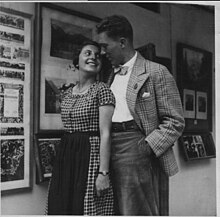Fritz Richter (painter)
Fritz Richter (real name Friedrich Richter ; born December 19, 1904 in Salzburg ; † May 20, 1981 in Berchtesgaden ) was a German graphic artist and painter, with a focus on artistic woodcut graphics.
Life
Richter was born as the son of the art dealer Eugen Richter and his wife Margarete, b. Bader, born in Salzburg. The parents came from Dessau . Richter attended school in his native Salzburg. In his short biography he wrote: “The school gave me the worst marks in marks - later the city gave me the silver medal. In spite of my teachers, I took up pencil and graver ”. He studied at the Leipzig Academy of Graphic Arts with Georg Belwe and then worked as a freelance artist with a focus on commercial graphics and woodcuts.
After a short stay in Munich , Richter lived in Berchtesgaden from 1931 until his death. From Berchtesgaden he went on study trips to Italy , France and the Balkans . During the Second World War he was drafted into military service for five years - what kind of military service was, whether z. B. as a soldier or medic is not known. From 1955 he suffered from an increasingly serious illness, so that he had to give up woodcutting and only painted and drew until his strength finally died down. But until the 1970s in Berchtesgaden, prints of his woodcuts were exhibited in a small building next to the Franciscan Church and offered for sale.
Fritz Richter was married, the marriage remained childless.
Creating art
Richter created over 150 woodcuts in addition to book illustrations and bookplates . Most of these woodcuts show the landscape around Berchtesgaden, the people who are rooted in this landscape with their work, their customs and traditions, their joys but also their sorrows.
In the early creative period, around 20 woodcuts were created that depict the suffering of the war in black and white colors and denounce the social divide of the 1920s. These prints can be attributed to the veristic style, which describes a provocative, realistic artistic style. Such cuts by Richter are to be mentioned here as: Grotesque of a city , And above us the sky as well as the saxophone plays death .
After 1931 and especially after the war, his subjects changed . Biblical motifs now increasingly shaped his works. With increasing age he turned to philosophical secular topics, especially with woodcuts to Goethe's Faust .
Many watercolors were created on his study trips, particularly in Italy. The mountain world of Berchtesgadener Land can also be found in many of his watercolors, not least after Richter was unable to make woodcuts due to illness.
Awards
- 1938: Silver medal from the city of Salzburg
- 1944: Culture Prize of the City of Salzburg
- 1961: Honorary Prize from the City of Salzburg
- 1966: Honorary Prize from the City of Salzburg
Exhibitions, purchases
As early as 1929, works by Richter were represented in leading exhibitions, such as every year in the Munich House of Art , Academy of the Arts (Berlin) , 1934 collective exhibition of the Munich Artists' Cooperative , 1936 in the Gurlitt Gallery in Berlin, 1941 in the Gustav Lübcke Museum in Hamm , 1962 in the Galerie Schumann in Munich, 1962 in the Kunstverein Coburg and of course several times in Berchtesgaden. His works were shown abroad: in 1934 in Budapest , Tokyo , Beijing ( China ), Lahore ( India ), in 1953 in the Picard Gallery (Paris), in The Art Institute of Chicago , in the Cooper Museum and the Metropolitan Museum of Art in New York .
Richter's works were purchased by the Bavarian and Anhalt states as well as museums from Munich and Salzburg, the Metropolitan Museum New York, the Museum of Art Rhode Island and other institutions such as the Eulenspiegel Museum in Mölln .
Bibliography (if known)
Standalone publications
- Berchtesgadener woodcut book . 50 woodcuts. Eugen Richter Verlag, Berchtesgaden around 1930
- I think . 23 woodcuts for the Bible. 24 sheets. Self-published , Berchtesgaden around 1950
- Fist . A series of woodcuts. 24 sheets. Self-published, Berchtesgaden 1953
- Berchtesgadener Jahrbüch'l . 50 woodcuts, illus. With text. Self-published, Berchtesgaden 1957
- Berchtesgadener Jahrbüch'l . 50 woodcuts. Self-published, Berchtesgaden 1974
- Wolfsteiner sketch sheets . 13 sheets. Gehringer, Kaiserslautern 1980
Illustrations
- Of de Barg (Ed.): When de Vugelbeer blooms . Song booklet for the great Ore Mountains controversy singing in honor of the award-winning groups and individual singers. Bruckmann, Munich approx. 1930
- Giovanni Boccaccio : The Decameron . With 50 woodcuts. Translated by Johannes von Guenther . Bertelsmann, Munich 1960
- Antonio Cornazano: Proverbs Novels . With 18 original woodcuts by Fritz Richter. Translated by Albert Wesselski . Müller & Kiepenheuer, Hanau 1967, 1998 ISBN 3-783387116
swell
- Fritz Richter’s estate
- Berchtesgadener Anzeiger No. 97 - Saturday, May 23, 1981 and Wednesday, December 7, 1983
- Dr. Hans Nachod: German book artist and commercial artist of the present . Special issue about Fritz Richter, Leipzig 1929
Web links
- Literature by and about Fritz Richter in the catalog of the German National Library
| personal data | |
|---|---|
| SURNAME | Richter, Fritz |
| BRIEF DESCRIPTION | German graphic artist and painter |
| DATE OF BIRTH | December 19, 1904 |
| PLACE OF BIRTH | Salzburg |
| DATE OF DEATH | May 20, 1981 |
| Place of death | Berchtesgaden |





